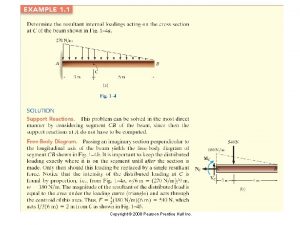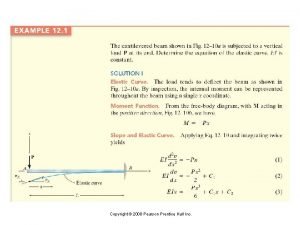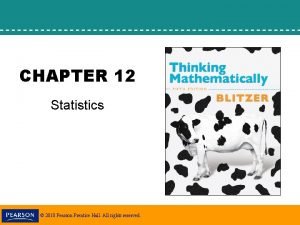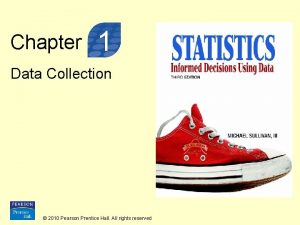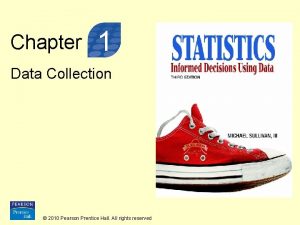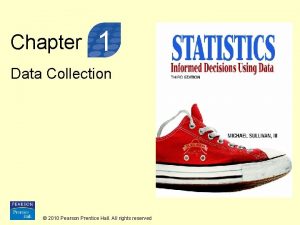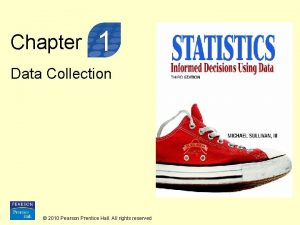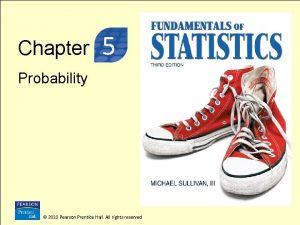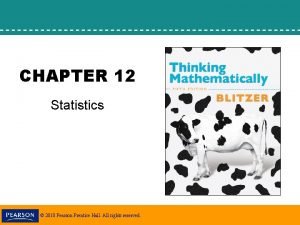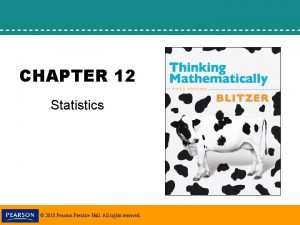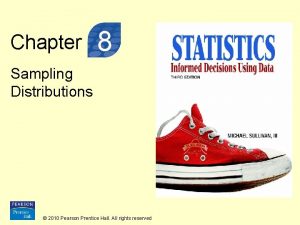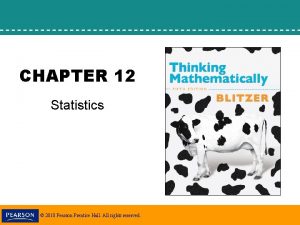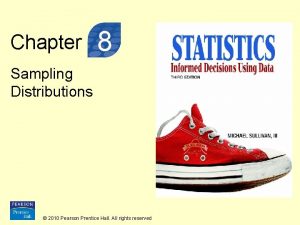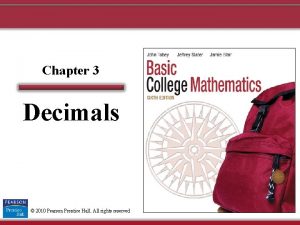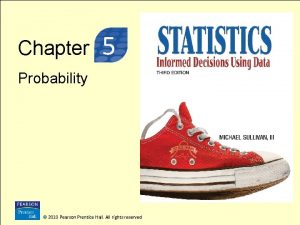Chapter 1 Data Collection 2010 Pearson Prentice Hall
















- Slides: 16

Chapter 1 Data Collection © 2010 Pearson Prentice Hall. All rights reserved

Section 1. 2 Observational Studies Versus Designed Experiments © 2010 Pearson Prentice Hall. All rights reserved

Objectives 1. Distinguish between an observational study and an experiment 2. Explain the various types of observational studies © 2010 Pearson Prentice Hall. All rights reserved 1 -3

Objective 1 • Distinguish between an Observational Study and an Experiment © 2010 Pearson Prentice Hall. All rights reserved 1 -4

© 2010 Pearson Prentice Hall. All rights reserved 1 -5

© 2010 Pearson Prentice Hall. All rights reserved 1 -6

In both studies, the goal of the research was to determine if radio frequencies from cell phones increase the risk of contracting brain tumors. Whether or not brain cancer was contracted is the response variable. The level of cell phone usage is the explanatory variable. In research, we wish to determine how varying the amount of an explanatory variable affects the value of a response variable. © 2010 Pearson Prentice Hall. All rights reserved 1 -7

An observational study measures the value of the response variable without attempting to influence the value of either the response or explanatory variables. That is, in an observational study, the researcher observes the behavior of the individuals in the study without trying to influence the outcome of the study. If a researcher assigns the individuals in a study to a certain group, intentionally changes the value of the explanatory variable, and then records the value of the response variable for each group, the researcher is conducting a designed experiment. © 2010 Pearson Prentice Hall. All rights reserved 1 -8

Designed Experiment or Observational Study? © 2010 Pearson Prentice Hall. All rights reserved 1 -9

Based on the results of this study, would you recommend that all seniors go out and get a flu shot? The study may have flaws! Namely, confounding. Confounding in a study occurs when the effects of two or more explanatory variables are not separated. Therefore, any relation that may exist between an explanatory variable and the response variable may be due to some other variable or variables not accounted for in the study. A lurking variable is an explanatory variable that was not considered in a study, but that affect the value of the response variable in the study. In addition, lurking variables are typically related to any explanatory variables considered in the study. © 2010 Pearson Prentice Hall. All rights reserved 1 -10

Some lurking variables in the influenza study: age, health status, or mobility of the senior Even after accounting for potential lurking variables, the authors of the study concluded that getting an influenza shot is associated with a lower risk of being hospitalized or dying from influenza. Observational studies do not allow a researcher to claim causation, only association. © 2010 Pearson Prentice Hall. All rights reserved 1 -11

Objective 2 • Explain the Various Types of Observational Studies © 2010 Pearson Prentice Hall. All rights reserved 1 -12

Cross-sectional Studies Observational studies that collect information about individuals at a specific point in time, or over a very short period of time. Case-control Studies These studies are retrospective, meaning that they require individuals to look back in time or require the researcher to look at existing records. In case-control studies, individuals that have certain characteristics are matched with those that do not. Cohort Studies A cohort study first identifies a group of individuals to participate in the study (cohort). The cohort is then observed over a period of time. Over this time period, characteristics about the individuals are recorded. Because the data is collected over time, cohort studies are prospective. © 2010 Pearson Prentice Hall. All rights reserved 1 -13

EXAMPLE Observational Study or Designed Experiment? Determine whether each of the following studies depict an observational study or an experiment. If the researchers conducted an observational study, determine the type of the observational study. a. Researchers wanted to assess the long-term psychological effects on children evacuated during World War II. They obtained a sample of 169 former evacuees and a control group of 43 people who were children during the war but were not evacuated. The subjects’ mental states were evaluated using questionnaires. It was determined that the psychological well being of the individuals was adversely affected by evacuation. (Source: Foster D, Davies S, and Steele H (2003) The evacuation of British children during World War II: a preliminary investigation into the long-term psychological effects. Aging & Mental Health (7)5. ) Observational study; Case-control b. Xylitol has proven effective in preventing dental caries (cavities) when included in food or gum. A total of 75 Peruvian children were given milk with and without xylitol and were asked to evaluate the taste of each. Overall, the children preferred the milk flavored with xylitol. (Source: Castillo JL, et al (2005) Children's acceptance of milk with xylitol or sorbitol for dental caries prevention. BMC Oral Health (5)6. ) Designed experiment © 2010 Pearson Prentice Hall. All rights reserved 1 -14

EXAMPLE Observational Study or Designed Experiment? c. A total of 974 homeless women in the Los Angeles area were surveyed to determine their level of satisfaction with the healthcare provided by shelter clinics versus the healthcare provided by government clinics. The women reported greater quality satisfaction with the shelter and outreach clinics compared to the government clinics. (Source: Swanson KA, Andersen R, Gelberg L (2003) Patient satisfaction for homeless women. Journal of Women’s Health (12)7. ) Observational study; Cross-sectional d. The Cancer Prevention Study II (CPS-II) is funded and conducted by the American Cancer Society. Its goal is to examine the relationship among environmental and lifestyle factors on cancer cases by tracking approximately 1. 2 million men and women. Study participants completed an initial study questionnaire in 1982 providing information on a range of lifestyle factors such as diet, alcohol and tobacco use, occupation, medical history, and family cancer history. These data have been examined extensively in relation to cancer mortality. Vital status of study participants is updated biennially. Cause of death has been documented for over 98% of all deaths that have occurred. Mortality follow-up of the CPS-II participants is complete through 2002 and is expected to continue for many years. (Source: American Cancer Society) Observational study; cohort © 2010 Pearson Prentice Hall. All rights reserved 1 -15

A census is a list of all individuals in a population along with certain characteristics of each individual. © 2010 Pearson Prentice Hall. All rights reserved 1 -16
 Prentice hall publishing
Prentice hall publishing 2011 pearson education inc
2011 pearson education inc Pearson education inc publishing as pearson prentice hall
Pearson education inc publishing as pearson prentice hall Pearson education inc. 2012
Pearson education inc. 2012 Pearson education inc publishing as pearson prentice hall
Pearson education inc publishing as pearson prentice hall 2008 pearson prentice hall inc
2008 pearson prentice hall inc 2008 pearson prentice hall inc
2008 pearson prentice hall inc 2005 pearson prentice hall inc
2005 pearson prentice hall inc Pearson prentice hall
Pearson prentice hall Ocean fisheries
Ocean fisheries Pearson prentice hall
Pearson prentice hall 2005 pearson prentice hall inc
2005 pearson prentice hall inc Arthropods common name
Arthropods common name Pearson education inc. publishing as prentice hall
Pearson education inc. publishing as prentice hall 2012 pearson education inc
2012 pearson education inc Pearson education inc. publishing as prentice hall
Pearson education inc. publishing as prentice hall Pearson education inc. publishing as prentice hall
Pearson education inc. publishing as prentice hall





